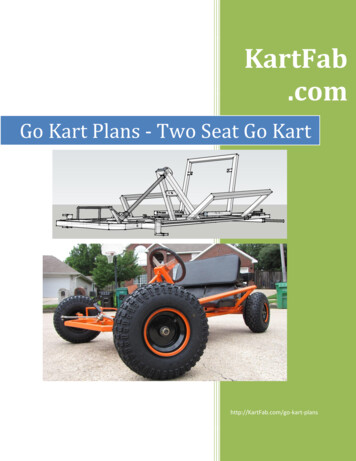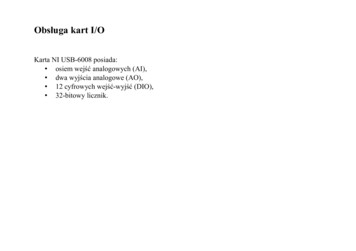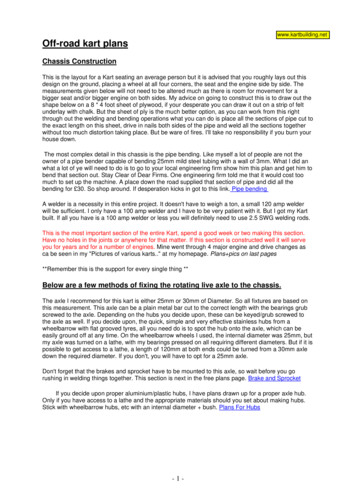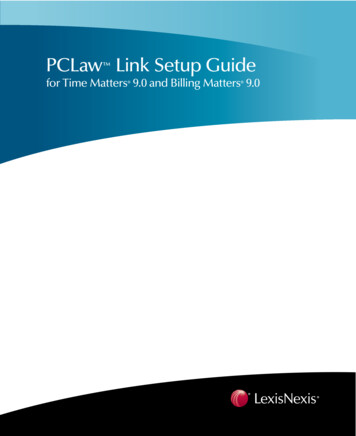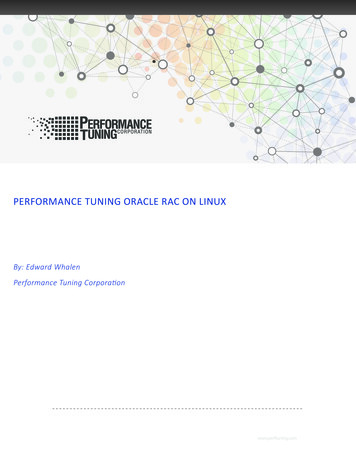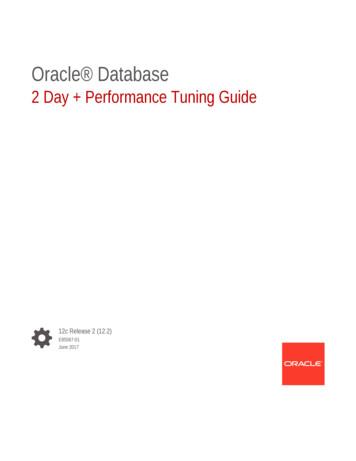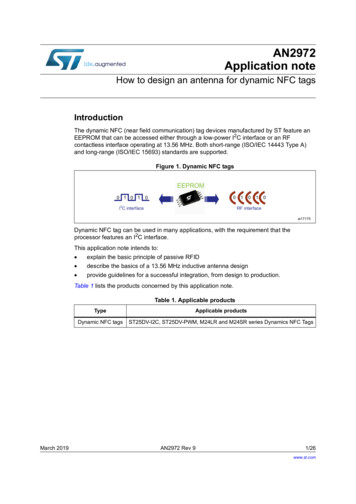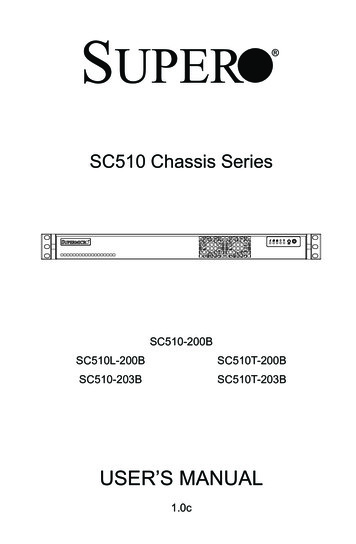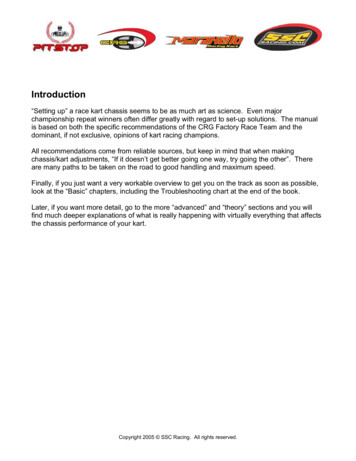
Transcription
Introduction“Setting up” a race kart chassis seems to be as much art as science. Even majorchampionship repeat winners often differ greatly with regard to set-up solutions. The manualis based on both the specific recommendations of the CRG Factory Race Team and thedominant, if not exclusive, opinions of kart racing champions.All recommendations come from reliable sources, but keep in mind that when makingchassis/kart adjustments, “If it doesn’t get better going one way, try going the other”. Thereare many paths to be taken on the road to good handling and maximum speed.Finally, if you just want a very workable overview to get you on the track as soon as possible,look at the “Basic” chapters, including the Troubleshooting chart at the end of the book.Later, if you want more detail, go to the more “advanced” and “theory” sections and you willfind much deeper explanations of what is really happening with virtually everything that affectsthe chassis performance of your kart.Copyright 2005 SSC Racing. All rights reserved.
Basic Chassis SetupBase Setup (Normal Track Conditions)The following settings are recommended as a starting point for a dry track with normal levels of grip(not “green” or slippery and also not with high amounts of rubber on the track, causing high grip).Weight distribution should be 43.0% front, 57% rear and 50/50% side to side.Front toe should be set out to 1/16” to 1/8” (1-3mm). For hard compound tires, set toe out at1/8” to ¼” (3-6mm).Caster/Camber adjusters at front spindles should be set at II top & II bottom.More caster may be needed over the weekend to fight tire wear and/or loss of grip.Front bumper should always be tight.Front width should be 45-1/2” to 46”.Side pod bars need to be loose, but with bolts tight.Seat should be at standard mounting points.Rear wheel hubs should be medium length.Rear ride height should be as low as possible.Rear track should be set just below the legal limit, within the rules (55” for many classes, 50” forjunior classes. A good starting point would be 54-3/4” for most applications.Axle should be the medium stiffness.Seat struts should be in place.Torsion bar should be in horizontal position.Rear bumper should be tightened.Tire PressuresHard compound tires (cold)Medium compound tires (cold)Soft compound tires (cold)12-13 psi9-10 psi8-9 psiCopyright 2005 SSC Racing. All rights reserved.
Basic Chassis TuningIf front end of kart is not gripping in corners (understeering):Move out one wheel spacer on both spindles.If front of kart becomes too wide, move wheels back to original spacing and changecaster/camber adjusters from II/II to II/III or III/III (be sure to re-check toe settings).Fit shorter hubs to rear axle. Be sure to measure from the hub face that meets the wheel to thechassis first (typically around 8-3/4”), so you can keep the same rear width measurement.Raise the hot rear tire pressures .5 to 1 psi.Remove seat struts, if fitted.Use a softer rear axle.If back end is sliding (loose) at entrance of the corner or there is too much front bite:Move in one wheel spacer on both spindles.Lower .5 to 1 psi in the rear tires.Move weight away from the front of the kart.Lower the front of the chassis (be sure to re-check toe settings).Put less caster in. Adjusters at I/II or I/I (be sure to re-check toe settings).Tighten the front bumper, if not already tight.Check to make sure your toe is set properly. 1-1.5mm on each side, while the kart is on a stand(slightly more for heavier drivers).Fit a stiffer axle.Fit longer rear hubs. Be sure to measure from the hub face that meets the wheel to the chassisfirst (typically around 8-3/4”), so you can keep the same rear width measurement.Fit seat struts (maximum of 4 total).Tighten rear bumper if not already tight.Raise rear ride height.The kart is hopping in the corners:Set the rear track as close to the legal limit, if not already there.Fit shorter wheel hubs on the axle. Be sure to measure from the hub face that meets the wheelto the chassis first (maximum legal width will be around 8-7/8” at the hub face), so you can keepthe same rear width measurement.Raise the air pressure in the rear tires by .5 to 1 psi.Lower any ballast to a lower vertical position (especially in the rear of the kart). This includesthe driver. In some very high grip situations, moving the seat forward, then angling the rear ofthe seat down will greatly lower the kart’s center of gravity (cg).Lower the rear ride height to the maximum, if not already done.Change to a softer axle.Remove seat struts.Copyright 2005 SSC Racing. All rights reserved.
Advanced Techniques and TheoryGeneral TheoryTo enable us to properly set up a kart chassis, we must first understand the most basic principals of theracing kart, which is a unit made up of tubes and front steering geometry, propelled through a live axle(one without a differential). Making adjustments to enable the race kart to turn without oversteer orundersteer is difficult and challenging. Achieving a well-balanced chassis set up is part art and partscience.Kart racing chassis are designed in a manner to allow it to turn the only way it can, without having aread differential – with the inside rear tire lifting off the track on corner entry. The outer rear tire drives“around” the outer front tire, allowing the chassis to efficiently turn into the corner because the rear tireis off the track surface.If the inner tire does not lift, no matter how much you turn the steering wheel, the front of the chassiswants to keep going straight, creating an understeer or “push” condition.Note: If the driver is not changing the direction of the kart properly, it is possible he/she is making a well-tunedkart behave badly. While this guide does not delve into driving techniques, here’s something to make sure youare on the right track:Observe where the proper apex (clipping point) is for each turn on the track. When you’re driving, eachtime you pass an apex in a corner, you should be starting to smoothly move the steering wheel back tothe center. If you do it properly, you will not have to “hold” the steering on, past the apex of the corner. Ifyou follow this technique and run out of usable track at the exit of the corner, you may have turned-in tooshallow at entry or your apex was too late. If you follow the technique and have too much usable track atthe exit of the corner, then you may have rotated the kart too hard at entry or your apex is too late in thecorner.If you are holding the steering past the apex, you are holding the kart down, and you probably need towork on your corner entry techniques. While this dynamic changes somewhat in shifter karts, the basicprincipal still holds true: The kart (and you) should do most of the work (change of direction) early in thecorner, so you can drive smoothly off the corner and not bind the kart down. Before completely changingyour baseline kart set up, be sure the problem isn’t the nut behind the wheel.When a chassis lifts up the rear wheel properly, then the chassis can pivot and turn. Therefore, the kartmust be set up with sufficient side grip to enable the inner-rear tire to lift upon entry, as it is faster todrive the kart through the corner than to try and slide through.Generally, when the chassis elements (axles, torsion bars, hubs, etc ) are on soft settings, the karthas less grip. As the chassis elements are made more rigid, grip will be increased. However, there arepoints of diminishing return where the chassis will get too firm to perform properly.The modern race kart will typically perform best when the rear width is set as wide as possible and thefront width is as narrow as possible, while still providing a fast, well balanced and stable package. Youcannot simply set the chassis on these min/max settings and hit the track, but this concept will helpcreate a target for your efforts to tune a happy chassis.Copyright 2005 SSC Racing. All rights reserved.
It is best to work on the end of the kart that is not handling well. If, for example, the problem isundersteer, try to solve the problem by first adding more grip. If that is not successful, try taking gripaway from the rear to balance the chassis.When a kart is properly set up, steering effort will be reduced and it will seem to “float” through thecorners. Remember, the front and rear of the kart must be in balance, with neither end too tight or tooloose. If you turn the steering wheel and the motor load increases, the chassis is “bound” and wastinghorsepower. Free up the chassis and gain horsepower!Engine power is wasted in several ways, including:Brake pad dragFriction in the wheel bearingsIncorrect wheel alignmentMisaligned engine/sprocketsSuch problems cause increased rolling resistance, which means more power is required to achieve thesame acceleration and speed. Since the engine doesn’t magically gain power to overcome rollingresistance, the kart just goes slower. If the increased rolling resistance is due to bad alignment, thekart will probably also handle poorly. Small improvements all add up to faster lap times and race winson the track. You may not think a blink of the eye amounts to much, but at most races it will meaneverything.Often the most stable set up is one where the kart tends to understeer just a bit into corners whileunder brakes and then turns to neutral steering when the power is applied and the kart is driven out ofthe corner. This is not massive understeer, just enough to show that understeer may be present. Akart set up this way is very stable into corners and is easy to drive. Remember, oversteer may be tonsof fun and look very exciting to the spectators. However, it is (unfortunately) slow!When setting your kart chassis, it is a good idea to find the longest corner and set the kart up to bouncejust a bit (just this side of hopping) on this corner. This bounce should not be enough to put you off line.It should be kept within easily controllable limits. The chassis is simply telling you that you aren’t slidingwith too little grip and you aren’t hopping with too much grip. If the kart is set up this way, then it will begiving maximum grip through the longest corner and this is where the greatest saving in lap times isavailable.Copyright 2005 SSC Racing. All rights reserved.
General Set Up ConditionsChassis AttitudeThe chassis attitude (frame in relation to the ground) should slope from front to rear, the front beingslightly lower than the rear. Adjusting the ride height with axle carriers in the rear and/or kingpin shimsup front, attains this.Engine TypesGenerally, 100cc karts will be set up to control understeer, as they do not have the power to requiremaximum rear grip. Excessive grip will slow the kart down overall. Shifter karts require a higheramount of weight on the rear wheels and more chassis tuning to create increased rear grip.Tall DriversTall drivers in 100cc karts will want to make adjustments to reduce grip in order to overcome theadditional leverage their higher center of gravity can produce. This may be done with more flexibleseats, a “MET30” or softer axle, maximum rear tread width, medium to short wheel hubs or no seatstruts. Drivers over 6’ may have to bolt-on (or have welded-on) and extended front porch. This willhelp lower the driver’s legs and maybe even allow the seat to be moved forward, then angled back inan effort to lower the center of gravity (cg) and “spread” the driver’s weight along the length of the kartinstead of on a vertical plane. Without these measures, it will be increasingly difficult for a tall driver totune a chassis as grip levels increase.Copyright 2005 SSC Racing. All rights reserved.
TerminologyAxle run-out: The variance of an axle from being perfectly round. This is usually measured with a dialindicator.Ballast: Weight, normally lead, added to raise he combination of kart and driver up the minimum legalweight for the racing class.Bearing Carrier: The element, normally three, in which the rear axle bearings are mounted.Caster: The tilting to the rear, of the top of the kingpin on which the front wheel spindle pivots.Camber: The tilting in, of the top of the front tires toward each other is negative camber. Tilting out ispositive camber.Chassis Lift: The raising of the inside rear wheel on corner entry. The lift or “jacking” is caused by acombination of frame stiffness, axle stiffness, caster and other factors.Chassis Bind: A combination of elements including too much frame stiffness, overly stiff axle, etc. thatcause the kart to have too much grip, restricting performance.Chassis Scaling: Weighing the kart and driver, preferably on digital scales, to determine weightdistribution.Clutch Kart: A single-speed kart with an automatic centrifugal clutch. Typically, this type of kart willhave a low revving four-stroke or a high revving 100cc two-stroke engine.Darting: An unstable condition where the kart is overly responsive to steering input.Digital Scales: Highly accurate electronic scales used to determine weight distribution.Frame Tweaking: The gradual bending of a kart frame to achieve optimum weight distribution.Grip: The level of adhesion between the kart tires and the track.Hopping: The kart bounce as throttle is applied near the apex of the turn.Jacking Effect: The raising of the inside rear wheel on corner entry. The lift (or “jacking”), is causedby a combination of frame stiffness, axle stiffness, caster and other factors.Kingpin: The pin (bolt) on which the individual front wheel spindle pivots.Live Axle: A single piece rear axle without the differential that allows the outside wheel to rotateindependently of the inside wheel when the vehicle is cornering. This forces both rear tires to try androtate at the same speed. Since they are moving around a different radius, one tire must lose this fight.Race karts are specifically prohibited from using axle differentials.Nylock Nuts: Nuts with a nylon center that allow it to lock securely to the bolt and avoid loosening.Copyright 2005 SSC Racing. All rights reserved.
Oversteer: A tendency for the rear of the kart to slide outward at corner entry or mid-corner. It’simportant to understand this tendency must be occurring as the kart enters the corner, not on cornerexit when application of power can cause “power induced oversteer”.Power Induced Oversteer: A tendency for the rear of the kart to slide outward at corner exit, underhard power application. Steady state throttle should not upset the chassis balance.Push/Kick: Occurs near the apex of the turn as the kart transitions from brakes to application ofthrottle. The kart rear kicks out suddenly at the apex.Pyrometer: A device used to measure the temperature of the tread of a kart tire, upon returning to thepits.Rear Track: The overall measured width of the rear, taken from the outside edges of the rear tires.Ride Height: The distance of the kart chassis from the track surface.Road Race (Enduro) Track: Normally a winding track that is over a mile in length and typically alsoused for automobile racing.Seat Strut: A brace mounted between the seat back and the bearing carrier to add chassis stiffness tothe rear of the kart chassis.Shifter Kart: A kart with a gearbox (normally six-speeds) and a manual clutch. Most shifter karts havean 80 or 125cc two stroke engines.Side Bite: lateral adhesion between the kart tires and the track surface.Slick Tires: Tires without tread to be used on a dry track.Spindle Bolt: The pin on which the individual front wheel spindle pivots.Sprint Track: A track, normally between ½ and ¾ miles in length, intended primarily for kart racing.Torsion Bar: Used to add or reduce chassis stiffness by adding reinforcement to the kart frame.Tire Compound: The degree of relative hardness (or softness) of a tire, influencing both adhesion anddurability.Toe: In - The condition of front-end alignment when the front edges of the tires are closer to each otherthan the rear edges. Out - The condition of front-end alignment when the rear edges of the tires arecloser to each other than the front edges.Understeer: The kart will not turn into the corner due to a lack of front end grip. Also known as “push”.Weight Distribution: The percentage of total weight on each tire or half of the kart.Wet Tires: Soft compound tires with full tread to be used under wet track or rain conditions.Wheel Spacer: A metal ring that slides over the front axle to change the front width of the kart.Copyright 2005 SSC Racing. All rights reserved.
Front End AdjustmentsSome of the most important handling adjustments are made at the front of a kart. Problems that occurwhen entering a corner are frequently due to an improperly adjusted front end. Front end bite andsteering response can be corrected by simple adjustments and toe setting is a good place to start.Set steering dead ahead during front wheel alignment and keep wheel movement suppressed byattaching a short bungee cord to the bottom of the steering wheel and running it either to the top of theseat or back over the seat to the rear bumper area. This should keep the steering wheel in place whileadjustments are made.Toe In/out:Toe settings will affect weight distribution, top speed and cornering response. The more toe in or toeout, the slower top speed becomes due to excessive drag by the tires. Despite this negative effect,increasing the toe out will increase initial cornering response, this giving the driver a better turn into thecorner and reducing understeer. However, if the kart is overly sensitive to steering wheel movement atthe point of turn in and begins to oversteer, the toe out settings may be too high. With toe out, theinside front wheels moves down in relation to the chassis more than it will with zero toe or toe in. On adry surface, a toe setting of 0-3mm out is recommended. For a very high speed track, setting close tozero toe may help top speed. Toe in is not normally used on a kart.Remember that the kart chassis will deflect under the driver’s weight and this deflection can affect toe,caster and camber settings in particular. Generally, the goal is to have zero toe when the chassis isloaded with the weight of full fuel and driver, sitting on the track. Therefore, a heavier driver will needmore unloaded toe out than a lighter driver.On road racing tracks in particular ( as opposed to the tighter sprint tracks), most karts will probablyhandle and accelerate better with the toe set to absolute zero when the kart is on the ground.However, on sprint tracks, slight toe out will help turn-in to corners, but rarely more than 2mm (on eachside), except in wet conditions, when larger toe out setting can be helpful.When setting the amount of toe, make sure that the toe is equal on each side.If you reset caster and camber settings or front ride height, you will have to reset toe as well.Ackerman:Ackerman steering makes the front tires turn at a different rate. For example, the front inside tire willturn faster than the outside tire when turning into a corner. This creates a faster steering response,thus causing flex through the chassis when turning. Adding Ackerman makes the kart steer morepositively and lift the inside rear tire at an increasing rate as steering is added. At the same time, thedriver will notice a decreased amount of steering input needed to turn the kart (because the inside rearwheel is being “jacked” more. As a result, the kart becomes more sensitive to the driver’s input. Incontrast, decreasing Ackerman makes the kart steer more slowly and more steering is needed tocorner.The spindles will usually have 2 tie rod hole locations; the inside hole increases Ackerman, while theoutside hole decreases Ackerman. The tie rods can be lengthened or shortened to fit either hole.Make sure you have sufficient threads on the rod ends when using the outer holes.Copyright 2005 SSC Racing. All rights reserved.
Caster/Camber Adjusters:The adjusters at the front spindles should start at a II/II (top/bottom) setting. Refer to the CRGcaster/camber chart at the end of this manual for the effect of various settings. Generally, karts arequire sensitive to caster adjustments and are not as sensitive to camber changes.Caster has the greatest effect at corner entry and during the first third of the corner. Camber has thegreatest effect in the middle third of the corner. The final third of the corner is controlled largely by rearaxle setup. If changes in none of these areas net any real change on the track, it’s probable that yourseat position is not correct and you are out of the tuning “window”.When caster and camber are both set correctly, there will be even wear across the tire face.Caster:Caster affects the grip of both the front and rear of a kart. It does this by transferring weight to theopposite rear wheel during cornering. Although it may seem complicated, there are a few simple rulesto follow concerning caster.If the caster is decreased (less kingpin angle), the kart will be easier to steer. Some drivers have notedthat it adds “feel” to the kart and increases bite on the front end. It may be advisable to decrease thecaster setting if the track conditions are providing too much grip. The kart will free up and be moredrivable if the caster is removed in this scenario.The driver may want to add caster if the conditions are cold or if the class requires hard compoundtires. This will offer more front grip, less rear grip and help eliminate understeer. For most applications,use the II/II settings on the front end adjusters. Smaller drivers will tend to run decreased caster, whilelarger drivers should run increased caster.Many teams take caster out of the chassis for qualifying, when tires are fresh and not fighting for grip.Caster also causes change of camber when the steering is turned, resulting in more negative camberon the outside front wheel and more positive camber on the inside front wheel.Importantly, increased caster also increases the jacking effect on the front wheels which helps unloadthe rear axle (inside wheel) more on corner entry. If a soft rear axle is being used, it is possible thatincreasing caster will alleviate an understeering condition by unloading the rear axle more and helpbalance the chassis. Since the rear tire is lifting sooner in the corner, there is (in effect) less rear grip atthis point.Generally, karts are fairly sensitive to caster changes. Therefore, it is quite effective as a primarytuning tool.Camber:Camber is measured by how far the front tires are leaning in or out as viewed from the front of the kart.If the tire is leaning “in”, the kart has negative camber. If the tire is leaning “out”, the kart has positivecamber.Camber is usually adjusted when the track surface is wet. In these conditions, the driver can negativelyadjust the camber to find more grip. Camber is the setting mostly responsible for maintaining themaximum outside front tire rubber on the road in the corners, particularly mid-corner. Setting camber tozero will nearly always be the best starting point and can be fine tuned using tire wear as a guide (ortire temperatures across the tread).Copyright 2005 SSC Racing. All rights reserved.
Front Width:The most common adjustment made to change the handling of a kart is by working with its front track,or front end width. Widening the front track will create more of a jacking effect when the wheels areturned. This will result in more front end grip and quicker turn in. Narrowing the front track will have theopposite effect. This will result in slower turn in and less front end bite.Also, the lack of jacking effect will not raise the inside rear tire (as much) on corner entry, preventingthe kart from rotating into the corner (as much) and increasing a “push” condition due to the excesstraction provided by both rear wheels remaining on the track.If the kart pushes or understeers entering a corner, widen the front track. If the front track is atmaximum width and the kart still pushes, move the front wheels back to your starting position adincrease the caster. In this scenario, you might also re-examine your seat position. If the kart is overgripping or “binds” on the front when the wheels are turned, reverse the procedure.A very general rule of thumb is; the less available grip, the more scrub radius (increase in front width),caster and starting tire pressure should be used. For more detail on the relationship between starting(cold) tire pressures and racing (hot) tire pressures, read the selection on tires.Copyright 2005 SSC Racing. All rights reserved.
Rear End AdjustmentsThe rear end adjustments include wheel hub length, track, rear ride height, axle stiffness, bearinglocations and seat struts. Changes to these settings are usually made when handling problems occuron the exit of the corner.Some have said that the entire kart should be regarded as a tuned spring. When you change the rearaxle stiffness, hub length or rear width, you’re actually tuning the spring’s “frequency”. You can “tune”the frequency and alter how/when the inside rear wheel comes up on corner entry, holds through thecenter of the corner and then sets back down on corner exit.Wheel Hub Length:CRG makes three different wheel hub lengths for their chassis. It’s highly recommended that a kartracer purchase all three of these sizes, as they are the most commonly adjusted setting on the kart andhave a significant impact on chassis balance.Think of the relation of the rear hubs to the axle and chassis as you would your hand to a pry-bar andan object at the other end of the bar. If you hold the bar at the farthest end of the bar or hold it with lessof your hand, you will have less leverage. Rear hubs on the axle work in much the same way.Longer hubs tend to provide more rear grip because the inside rear wheel will spend more time on thetrack surface. So if the kart oversteers as it exits a corner, a longer hub may be desirable.Short hubs are used when the kart understeers at the exit of the corner. If the driver runs out of tracksurface as he/she exits the corner the kart has a “push” on exit. While it’s not the only possiblechange, switching to shorter hubs will reduce grip at the rear and may be desirable in a situation likethis. The shorter hubs have a lower “frequency” and will allow the inside rear tire to stay off the tracksurface longer, and the kart will have less grip on corner exit.Overall choice of hub length should ultimately be based on how flat the tire is wearing. If the kart isrunning little caster, a soft axle and generally feels good, but the rear tires are “coning” (the inside of thetire is wearing faster than the flat or outside), decrease the rear width. If the problem persists, increasethe hub length or turn the bearing carriers facing out to support the axle end more.Rear Track:The general rule is to run the rear of the kart as wide as feasible, assuming the chassis is performingwell. For sprint racing in the US, most rules dictate a maximum rear track of either 52 or 55 inches.Most CRG manufactured chassis are specifically designed for rules allowing a 55” rear track width.Therefore, it is important to set the kart’s rear track to the maximum that the rules allow. Also, a widerrear tread will provide a smoother ride.There is an interrelationship between rising/falling grip and stability in the 52” to 55” range withmaximum grip in the 54” range. Smaller track width dimensions will provide more grip, but at theexpense of stability.However, this adjustment is made as a last resort. The driver should change to short wheel hubsbefore decreasing the rear track width narrower than 54-1/2”. If necessary, narrow the rear track in 1/8”increments, as most chassis are very responsive to minor changes if the seat is in the correct position.Copyright 2005 SSC Racing. All rights reserved.
Generally, it’s best to start at 54-3/4”, as this gives the ability to narrow or widen the rear for slightlymore or less grip if needed to balance the chassis. Each side is only 1/8” away from the maximum of55”. It becomes necessary to narrow the track when the rear of the kart has too little grip. Keep theoperating range of movement on the rear width in a fairly small range.Narrower: more grip, but less stableWider: more stable, but less gripAxle Stiffness:There are a wide variety of axle hardness available for CRG chassis. The axle has a very stronginfluence on rear grip characteristics. In almost all cases, you will use a mid-range axle. The hard orstiff axle is used when the weather is cold, in slippery track conditions or when rules mandate the use ofharder compound tires. The softer axle is used if conditions are extremely grippy or where excessrubber has built up.In general, higher horsepower karts need stiffer axles for more traction. Lower horsepower karts havea greater need to “free” up the chassis and will run softer axles. Remember the spring frequency“tuning” comparison. The softer the spring, the more/longer the inside rear wheel will stay up.Tall drivers generally will need softer axles to help reduce grip.Axle Offset and Length:If you’ve moved the rear track to 55”, installed a soft axle and short hubs and still just need a little lessgrip on one side of the kart (for a track with the longest turns in one direction). If you find yourselfwishing you could go to 55-1/4” on one side, you could try offsetting the rear axle to the other side ofthe kart. If all the other measurements (rear track width and type of hubs) stayed the same, the sidewith the shorter axle will have less leverage and therefore less grip.Another way of accomplishing this for both sides is to install a shorter axle of the same hardness. Inthis case, both sides will have less leverage. In either case, be sure the hub still has enough axle tohold onto.Rear Ride Height:Most chassis have two settings for the rear ride height. The chassis should be run with the higher rideheight
Copyright 2005 SSC Racing. All rights reserved. It is best to work on the end of the kart that is not handling well. If, for example, the problem is

